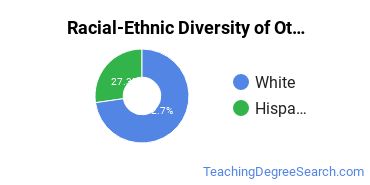Undergraduate Certificates in Other Special Education & Teaching
Education Levels of Other Special Ed Majors
During the most recent year for which data is available, 31 people earned their undergraduate certificate in other special ed. The following table shows the number of diplomas awarded in other special ed at each degree level.
| Education Level | Number of Grads |
|---|---|
| Master’s Degree | 582 |
| Bachelor’s Degree | 358 |
| Graduate Certificate | 220 |
| Basic Certificate | 47 |
| Undergraduate Certificate | 31 |
| Doctor’s Degree | 6 |
| Associate Degree | 2 |
Earnings of Other Special Ed Majors With Undergraduate Certificates
We are unable to calculate the median earnings for other special ed majors with their undergraduate certificate due to lack of data.
Student Debt
We do not have the data to calculate the median and range of debt loads for other special ed students who are undergraduate certificate holders.
Student Diversity
More women than men pursue their undergraduate certificate in other special ed. About 74.2% of graduates with this degree are female.
| Gender | Number of Grads |
|---|---|
| Men | 8 |
| Women | 23 |

The racial-ethnic distribution of other special ed undergraduate certificate students is as follows:
| Race/Ethnicity | Number of Grads |
|---|---|
| Asian | 2 |
| Black or African American | 4 |
| Hispanic or Latino | 4 |
| White | 20 |
| International Students | 0 |
| Other Races/Ethnicities | 1 |

Explore Major by State
Alabama
Arkansas
Connecticut
Florida
Idaho
Iowa
Louisiana
Massachusetts
Mississippi
Nebraska
New Jersey
North Carolina
Oklahoma
Rhode Island
Tennessee
Vermont
West Virginia
Related Majors
Below are some popular majors that are similar to other special ed that offer undergraduate certificates.
| Major | Annual Degrees Awarded |
|---|---|
| Teaching for the Deaf | 79 |
| General Special Education | 56 |
| Early Childhood Special Education | 29 |
| Teaching for Speech Impaired | 4 |
References
*The racial-ethnic minority student count is calculated by taking the total number of students and subtracting white students, international students, and students whose race/ethnicity was unknown. This number is then divided by the total number of students at the school to obtain the percentage of racial-ethnic minorities.
- College Factual
- National Center for Education Statistics
- O*NET Online
- Bureau of Labor Statistics
- Image Credit: By woodleywonderworks under License
More about our data sources and methodologies.
